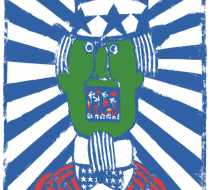End Bad Breath Favorite
Wired Article:
IN 1957 SEYMOUR Chwast published a book titled A Book of Battles. It was 24 pages of hand-colored linocut illustrations depicting infamous battles waged throughout history. Chwast, by then a partner at the famed graphic design outfit Push Pin Studios, had long been an anti-war activist, having grown up in 1940s Coney Island, New York, which, at the time, was a bastion of liberal political activity. “Radicals against war, for women, for civil rights“ he recalls. “I sort of become part of that whole scene.”
Chwast made 80 copies of the book but never really promoted the fact it existed. Now, nearly 60 years later, he’s creating a follow up to A Book of Battles, titled *At War With War, *now raising funds on Kickstarter. Chwast’s new book is a series of 35 hand-drawn, black-and-white illustrations that, like its predecessor, depicts some of history’s most iconic battles. The book follows a 5,000-year timeline of warfare, with Chwast only illustrating the most visually compelling of the wars.
One of the Kickstarter rewards.
SEYMOUR CHWAST
Of course, a lot has happened, warfare-wise, in the past 60 years. Fighting has gotten smarter and deadlier, and Chwast acknowledges this through his illustrations. Unlike A Book of Battles, in which Chwast sought to depict war objectively, At War With War is very much a political statement. Chwast chose to keep his illustrations colorless, only using a symbolic red for the timeline’s text. “Putting them all in color would just glamorize them,” he says. “I didn’t want to make them into pretty pieces at all.”
The style of each illustration shifts to reflect the war it’s depicting. The page accompanying the bombing of Hiroshima, Japan, for example, is strewn with a haunting pattern of dark silhouettes of those decimated by the atomic bomb. Meanwhile, the image depicting the Iraq war is a bold and exacting woodcut illustration of a soldier outfitted with high-tech gear. Chwast chose to let the images and events speak mostly for themselves, figuring the sheer number of wars would be compelling enough to make his point. “Pictures are powerful,” he says. “Often much more powerful than words.”
Illustration has long been a vehicle for Chwast to vocalize his political unrest. One of his most famous posters, "End Bad Breath," is an example of how an image can spark a political revolution. The 1968 anti-Vietnam war illustration shows a green-faced Uncle Sam, his mouth agape. Inside of it, bombs are dropping onto Hanoi. It’s a clear piece of visual communication whose message is unmistakable. That lack of ambiguity is the mark of graphic design, Chwast says. “Graphic design is a good way to express ideas quickly,” he says. “It does exaggerate but there is truth to it.”
Most graphic design exists to communicate a message, if not persuade through simple, evocative means. This makes it a particularly good modality for activism. It takes little effort to look at a book, and less to glance at a poster. Chwast says he doesn’t figure his book will do much to prevent future wars from happening, but at the very least, he says, At War With War can serve as a record of mankind’s worst, unrelenting impulse.







